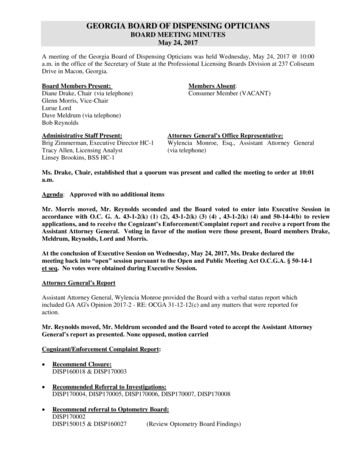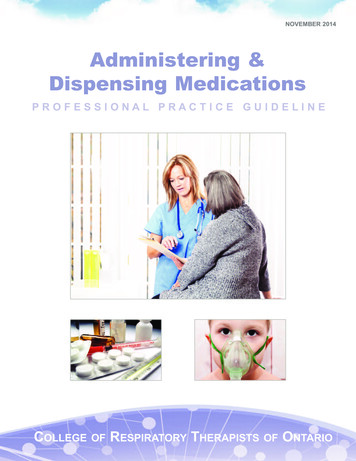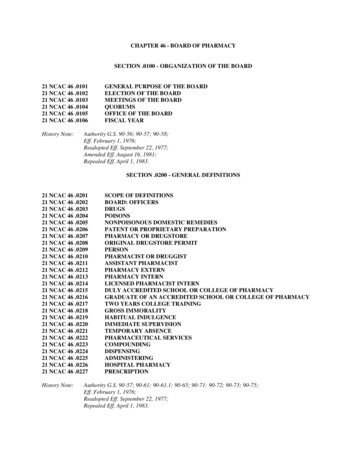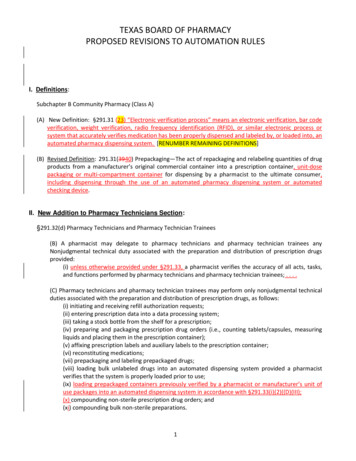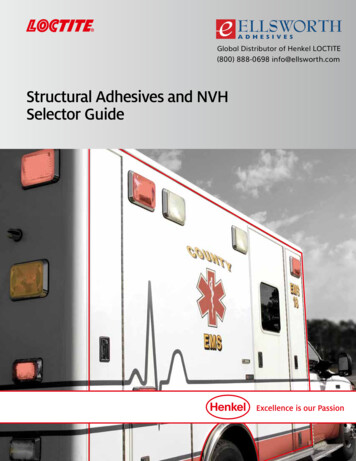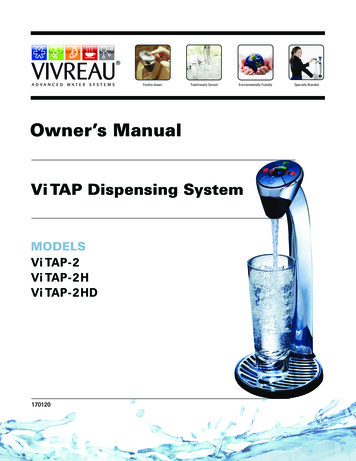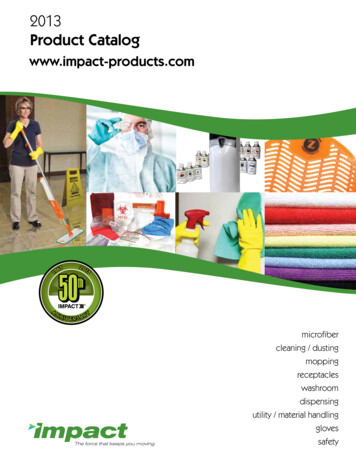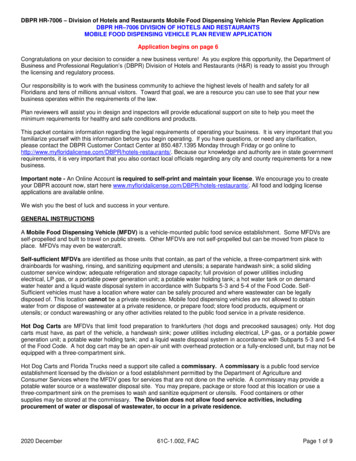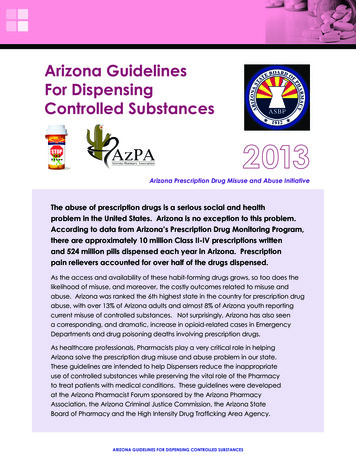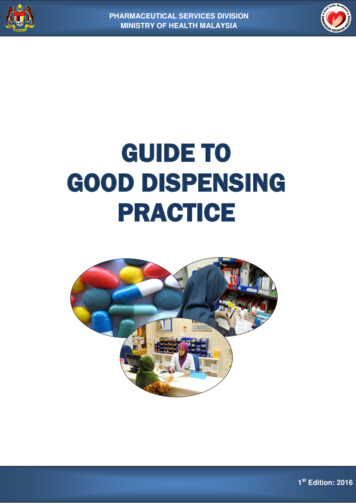
Transcription
PHARMACEUTICAL SERVICES DIVISIONMINISTRY OF HEALTH MALAYSIAGUIDE TOGOOD DISPENSINGPRACTICE1st Edition: 2016
This guide has been developed based on the Poisons Act 1952 (Revised 1989), PoisonsRegulations 1952, Poisons (Psychotropic Substances) Regulations 1989 and other related acts,guidelines and standards which are currently being used in Malaysia.The purpose of this guide is to ensure that medicines are dispensed in accordance with thelaws and guidelines mentioned above in both government and private healthcare facilities andthat patients receive the medicines correctly through which adherence can be improved,occurrence of adverse reactions minimised and medication errors avoided.Guide to Good Dispensing Practice: 2016Page 1
CONTENTS1. Introduction32. Scope33. Dispensing ProcessA. Processing the Prescriptioni.Screening4ii.Interpreting the Prescription Order5iii.Handling Prescriptions which RequireClarification5iv.Handling Prescriptions in a Stock-Out Situation5B. Preparing the Medicinesi.6ii.Fillinga) Selecting the Medicinesb) Extemporaneous Preparation/CompoundingLabellingiii.Checking87C. Counter-Checking8D. Recording9E. Issuing Medicines to the Patient104. Dispensing Process Flow Chart115. Medication Counselling126. Maintaining Pharmaceutical Stocks127. Disposal of Pharmaceutical Stocks128. Supply of Medicines on Long-term prescription139. Delivery of Repeat Medicines by Post1310. Non-Prescription ferences17Guide to Good Dispensing Practice: 2016Page 2
1. IntroductionDispensing refers to the process of preparing and supplying medicines to a namedperson together with clear instructions, advice and counselling where necessary on theuse of those medicines. It involves the correct interpretation of the order for prescribedmedicines and accurate preparation and labelling of medicines for use by the patient.The dispensing process includes all activities that occur between the time theprescription or request for medicine is presented up to the time the medicines or otherprescribed items are issued to the patient.Good Dispensing Practice ensures that the right medicines of desired quality aredelivered correctly to the right patient with the right dose, strength, frequency, dosageform and quantity, together with clear instructions, both written and verbal and withappropriate packaging suitable for maintaining the quality and efficacy of the medicine.A safe, clean and organised working environment provides the basis for gooddispensing practice. The dispensing environment includes1:Qualified / trained staffAppropriate physical surroundingsAdequate shelving and storage areasProper work surfacesSuitable equipmentNecessary packaging materialsResponsibility for the accuracy and quality of the medicines supplied lies on the personsoverseeing the dispensing process. It is important that the staff dispensing medicinesare trained and equipped with the technical knowledge and the skills necessary todispense the range of medicines prescribed and to communicate effectively withpatients/ caregivers.2. SCOPE1.2.3.4.Applicable to Group B and C of Poisons ListsMedicines for human use onlyApplicable to public healthcare facilitiesApplicable to the licensed private healthcare facilities (clinics, hospitals,community pharmacies, dental clinics)**not applicable to veterinary clinicsGuide to Good Dispensing Practice: 2016Page 3
3. Dispensing ProcessAdherence to good dispensing procedures is vital in ensuring that medicines aredispensed correctly and any potential/ real errors which may occur during the dispensingprocess are detected and rectified before medicines reach the patient.Who should be involved in the process of dispensing:a) Screening of Prescription: Healthcare professional (Registered medicalpractitioner/ registered dentist/ pharmacist)b) Preparation of Medicines2: Pharmacist, registered medical practitioner or aperson under immediate supervision of a pharmacist/ medical practitionerc) Supplying the Medicines2: Registered medical practitioner, registered dentist orpharmacistd) Counselling : By healthcare professionalDispensing of Psychotropic SubstanceRegulation 11 of Poisons (Psychotropic Substances) Regulations 1989 stated that nopsychotropic substance shall be sold or supplied for the purposes of medical or dentaltreatment of a particular patient except by a registered medical practitioner or registereddentist or pharmacist (upon a prescription by doctor or dentist).Under the Regulation 16 of the same Regulations, it is stated that only a registeredmedical practitioner or registered dentist or a person acting in accordance with thedirection of a registered medical practitioner/ registered dentist shall administer anypsychotropic substance. The psychotropic substance is administered for the purpose ofmedical or dental treatment of a particular patient4.Processing the PrescriptionA-i. ScreeningOn receiving a prescription, it should be screened and validated to ensure that it is forthe correct patient and it complies with the requirements in the Poisons Act.The prescription should be written legibly or printed.The prescription should have the following information2:Patient Details1. Name2. Address3. Identification number(IC/Passport No)Guide to Good Dispensing Practice: 2016Prescription Details1. Drug regimen (name ofmedicine, dose,frequency, administrationand duration)2. Doctor’s signature, stampand registration number3. Doctor’s name andaddress4. Date of prescribingPage 4
Names of medicines prescribed should be written in generic name and abbreviationsshould not be used. Brand (trade) names should be avoided as far as possible. If apatient must be given a particular brand, it should be indicated on the prescription.Age of the patient and body weight should be stated on prescriptions for childrenunder 12 years of age.A-ii. Interpreting the Prescription OrderThe person receiving the prescription should check for:o Dose, frequency and durationo Drug interactions, medicine duplication, polypharmacy, inappropriate drugtherapy, contra-indications.o Allergieso Unusual usage and suspected drug misuse or abuse.For partial medicine supply, ensure that the second or subsequent supply does notexceed the quantity for the duration prescribed.A-iii. Handling Prescriptions which Require ClarificationIf an incomplete prescription or one which requires further clarification is received,attempts must always be made to contact the prescriber:i. If the prescriber can be contacted and is available on site, arrange for theincomplete/missing details to be inserted on the prescription by the prescriber.Remedial action for such prescriptions should be discussed with the prescriberprior to sending the prescription back to him/her.ii. If the prescriber is not available to amend the prescription himself/herself,authorisation to make the change may be obtained verbally through the phone.iii. The amendments to the prescription should be repeated back to the prescriber toensure accuracy. The amendments should be documented on the prescriptionand endorsed with “PRESCRIBER CONTACTED” (PC), dated and initialled by thepharmacist/person dispensing.iv. If the prescriber cannot be contacted, patient should be informed and theprescription must be sent back to the prescriber with information on theclarification/action needed.v. Prescriber should document any changes made to the patient’s medical record.A-iv. Handling Prescriptions In A Stock-Out SituationStock-out is defined as a situation where the prescribed medicine is not available at thepharmacy when a prescription is being processed. This may be due to the medicinebeing temporarily out-of stock at that time or the pharmacy does not keep stock of thatparticular medicine.If such situation occurs:i. Inform the prescriber. If the medicine cannot be substituted with anothermedicine that is available, inform the patient.ii. If the patient agrees for it to be supplied at a later time, arrange to get stocks soGuide to Good Dispensing Practice: 2016Page 5
as to enable prompt supply the medicine to the patient;iii. If the patient requires the medicine urgently, the pharmacist/person dispensingmust communicate with the prescriber to discuss if the prescribed medicine canbe substituted with another medicine which is readily available.iv. Any substitution of medicine must be approved by the prescriber anddocumented on the prescription.v. Prescriber should document these changes in the patient’s medical record.Preparing the MedicinesB-i. Fillinga) Selecting the MedicinesWhen selecting the medicine to be dispensed, prevent any medication errors byestablishing an appropriate system to ensure that the correct medicine is selected,especially if there are medicines with similar names and packaging. Pick themedicine by reading the label at least twice and cross-checking the medicine nameand strength against the prescription.If a barcode system is available, it should be used to enable correct and accurateselection of the medicine.Check the expiry date of dispensed medicines to ensure that they remain unexpiredfor the duration of the supply course.Medicines should be dispensed in original packaging as far as possible.Tablets/capsules should not be removed from the strip/blister when dispensing.Bulk loose packs for supply are not encouraged. Avoid direct contact with the hand ifloose packs are to be used.Medicines which need to be packed such as loose capsules/tablets should be packedinto a clean, dry container, such as a bottle or plastic envelope which will notcompromise the quality of the product after dispensing.b) Extemporaneous Preparation/ CompoundingExtemporaneous preparations should only be prepared if there is no equivalent productavailable commercially and the product has to be compounded based on the patient’sneeds.For compounding of psychotropic substance, no person shall dispense, compound or mixany psychotropic substance with any other substance, whether a psychotropic substanceor not, for the purpose of it being used for medical, dental or animal treatment unless heis a licensed pharmacist; or a pharmacist in the public service. However, a pharmacyassistant or medical assistant employed in any government facility may also compound ormix any psychotropic substance for the purpose of medical treatment upon prescriptionprescribed by a registered medical practitioner or registered dentist4.Compounding of extemporaneous preparation should only be done on a patientspecific basis.Ingredients used for compounding are sourced from recognised pharmaceuticalGuide to Good Dispensing Practice: 2016Page 6
suppliers.Ensure that the preparation is prepared according to formulation from a reputablereference. Suggested references are stated in Appendix 1.There should be worksheets for the compounding which should be checked by a staffmember knowledgeable in compounding and counter-checked by a pharmacist/another qualified staff member / doctor.Staff involved in compounding should be competent to perform this task under thesupervision of pharmacist or registered medical practitioner.Availability of requisite facilities and equipment (Appendix 2) which are maintainedin good order.In a situation where hazardous substance, such as cytotoxic medicines (as listed underNIOSH List of Antineoplastic and Other Hazardous Drugs in Healthcare Settings14) is tobe handled, staff should use appropriate Personal Protective Equipment (PPE) andfollow the stipulated procedures.Once the preparation is ready, label the product with necessary particulars includingexpiry date/ special requirements for safe handling and storage.Keep worksheets or record books for a minimum of two years. The document shouldcontain information as below: Formula Ingredients and quantity used Manufacturer, batch number and expiry date of ingredients used Patient & prescription details Names of persons involved in preparing and counterchecking the product Date of compoundingNote: The MOH Extemporaneous Formulation10 and Garis Panduan Pembancuhan(Compounding) Sediaan Ekstemporanus11 can be used as references.B-ii. LabellingEvery medicine containing any scheduled poison sold or supplied must be preparedand labelled by or under the immediate personal supervision of the medicalpractitioner or dentist3.All dispensed medicines should be labelled according to the requirement stated bylaw. It is advisable for labels to be printed. If handwritten, it should be neat andlegible with clear instructions on use.Label should contain: Name, address, and contact number of hospital / clinic / pharmacy Patient’s name Name of medicines (generic and/or trade names) Dosage form with the strength and quantity per unit dosage form: mg/mlof liquid, mg/g for semi-solid preparations Directions for use: dose, frequency and duration (if necessary) Date of supply Expiry date (especially if dispensed medicine is not in its originalGuide to Good Dispensing Practice: 2016Page 7
packaging) “Controlled Medicine” or ”Ubat Terkawal” should be labelled for allcontrolled medicines Medicines for external use should be dispensed in suitable containers andshould be labelled conspicuously with the words “Not to be Taken” or“For External Use Only” in Bahasa Malaysia and/or English printed in redOR on a red background Special precautionary labels should be used where necessary (e.g.,“Complete the course” for antibiotics, “May cause drowsiness” forsedating drugs, etc)Whenever possible, always dispense the medicine in its original packaging so thatpatients will have access to the product information.If a medicine is not dispensed in its original packaging and it is not possible to include allthe necessary information on the label, it should be written/printed separately anddispensed together with the medicine. Patient information leaflet (PIL) should beprovided, where available. Approved PILs can be downloaded from the NationalPharmaceutical Regulatory Agency (NPRA) website at http://npra.moh.gov.my/ underPublic - Risalah Maklumat Ubat Pengguna (RiMUP).B-iii. CheckingCheck the prescription and the filled medicines to ensure that the filled medicinescorrelate with the prescriptionCounter-CheckingCounter-checking should be done by a second person, other than the staff who didthe previous filling and labelling tasks.Check all the medicines prepared for dispensing against the prescription.Once the counter-checking is done, the person performing this task should initial onthe prescription.Guide to Good Dispensing Practice: 2016Page 8
RecordingProper record keeping is an essential part of dispensing as it facilitates good managementand monitoring of services provided. Such records can be used to verify the stocks used indispensing, and will be required if a need arises to trace patients dispensed with aparticular medicine.All sale or supply of poisons in private facilities must be recorded in a “PrescriptionBook” on the day of the sale or supply2.The following particulars need to be recorded:1.2.3.Date of sale or supply and the serial number of the entry of the prescription (ifany);Name of the active ingredients of the medicine or in the case of a proprietarymedicine, the name of the medicine and the quantity suppliedName and address of the patientAll sale or supply of Psychotropic Substances must be recorded in a “PrescriptionRegister for Psychotropic Substances” on the day of the sale or supply4.The following particulars need to be recorded:1.2.3.4.5.6.7.Date and serial number of sale or supplyName and strength of the psychotropic substance and the quantity sold/supplied/ administeredName, identity card/passport number and address of the patientThe balance stock should be updated for each supply of the psychotropicsubstance in possessionThe required entry must be in chronological order with respect to the previousentries in the registerAny correction to the entry must be made by way of a marginal note or afootnote which must specify the date on which the correction is made.Correction should not be made by cancellation / deletion /using liquid paper.Each strength or type of psychotropic substance must be recorded in a separateregister or a separate part of the registerAll record books must be in the form of a bound book4. Records kept as soft copymust be printed daily (if there is a transaction) and form a bound book.Guide to Good Dispensing Practice: 2016Page 9
Issuing Medicines to the PatientIssuing or supply of medicine should only be done by registered medical practitioner or apharmacist2. When dispensing the medicines, ensure the 5Rs: Right PatientRight MedicineRight DoseRight RouteRight TimeCheck the name and ID to verify the right patient.Medicines supplied for a person under 18 years of age is for the purpose of hismedical treatment only2.Ask about allergies or known adverse drug reactions (ADR).Give clear instructions and proper advice on how to take/ use the medicinesdispensed.Ensure the patient is made aware if there are special requirements duringtransportation, proper storage conditions and usage requirements for themedicines.Compliance aids (e.g. measuring spoon or syringe) for the appropriate dose shouldbe provided, if required.Every effort must be made to ensure that the recipient understands theinformation/instructions and advice provided.Advise patients to inform the clinic/pharmacy should they encounter any adversedrug reactions (ADRs) when taking the dispensed medicines.Supply of medicines based on prescription, the name of the person who dispensedthe medicines, address and the date of supply should be written on the prescriptionabove the doctor’s signature as a form of endorsement.Guide to Good Dispensing Practice: 2016Page 10
4. Dispensing Process Flow ChartStartPerson AReceive Prescription (Rx)Person AScreen and process Rx- Validate Rx- Interpret Rx- Check availabilityof stockPerson AYesIssue?ContactprescriberNoPerson BPrepare Medicine- Filling- Labelling- ExtemporaneousPreparation, ifnecessaryPerson BRecordingPerson ACounter-checkIssue?YesRectifyNoPerson AIssue medicine to patientFinishPersons A or B refers to different personnel doing the task to minimise any possible error.a) Preparation of medicine for dispensing can be done by medical practitioner/ registereddentist/ pharmacist or a person under their immediate supervision for the purpose of itbeing used for medical treatment.b) Only a medical practitioner/ registered dentist/ pharmacist can dispense medicines withproper instructions.c) Any procedure involving psychotropic substance should follow the regulations stated underPoisons (Psychotropic Substances) Regulations 1989.Guide to Good Dispensing Practice: 2016Page 11
5. Medication CounsellingWhere necessary, provide medication counselling to patients to ensure proper use ofmedicines dispensed.It is encouraged to counsel patients with chronic diseases on multiple medications.Maintain records of the counselling done.6. Maintaining Pharmaceutical StocksStore all medicines in the original containers as supplied by the manufacturer. If thecontents need to be transferred to other containers (pre-packing), care must betaken to avoid contamination and mix up. The new containers of the pre-packed /repacked medicines should be labelled appropriately with: Name, address, and contact number of clinic/pharmacy Name of medicines (generic and/or trade names) Dosage form with the medicine strength (mg of tablet, mg/ml of liquid,mg/g for semi-solid preparations) Manufacturer batch number Manufacturer expiry dateStore medicines under suitable conditions, taking into consideration the generalusage of the medicine (internal/ external item should be segregated/ storeseparately), stability of the drug and manufacturer recommendations.Protect medications from contamination, sunlight, moisture and adversetemperatures.All psychotropic substances must be stored in a locked cabinet, safe or receptacleand can only be locked or unlocked by the registered medical practitioner orpharmacist4.Application of Tallman Lettering, Handling of Look Alike, Sound Alike Guideline andHigh Alert Medications Guideline in arranging medication stocks is encouraged inorder to prevent medication error.7. Disposal of Pharmaceutical StocksSegregate deteriorated/ recalled/ expired/ returned medicines for proper disposaland store in an appropriate bin/ container to prevent unauthorised access.Management of disposal of expired/ returned medicines should follow as below:1. Poisons (Psychotropic Substances) Regulations 19894 for disposal ofpsychotropic substance – needs to be witnessed by a Pharmacy EnforcementOfficer, Ministry of Health.2. The Guidelines on the Management and Handling of Clinical Waste inMalaysia17 by the Department of Environment, Ministry of Natural Resources& Environment for disposal of medicines.Guide to Good Dispensing Practice: 2016Page 12
8. Supply of Medicines on Long-term PrescriptionPartial supply of medicines is based on the validity of the prescription and durationfor its supply.Ensure that a copy of the original prescription is kept for recording purposes. Also,ensure that the quantity supplied by the pharmacy is recorded on the originalprescription as reference for the next supply.The original prescription should be returned to the patient as it will be required forthe next supply.9. Delivery of Repeat Medicines by PostFirst time supply must always be dispensed at the pharmacy counter.Delivery service should ONLY be provided for prescription that is partially-supplied.The delivery service is only applicable when it has been established that thepatient/caregiver understands the use of the medicines and direct face-to-facecontact with the patient or caregiver is deemed not necessary for subsequent refillsof the prescription.Criteria for eligibility:Only stable and compliant patients should be eligible to receive medicinesthrough the delivery service.Only partial supply medicines for chronic diseases should be considered fordelivery services. Only medicines that do not require specific storage conditionscan be delivered through post.Psychotropic drugs and medicines containing pseudoephedrine, ephedrine,codeine and tramadol should not be delivered by post.Agreement from the patient must be obtained prior to providing the delivery serviceand appropriate records of requests for the service must be kept.The delivery mechanism used must be secure and medicines delivered promptly tothe patient so as not to compromise on the quality of the medicines and to ensurecontinuity of their medicines.Note: The Garis Panduan Perkhidmatan Ubat Melalui Pos 1Malaysia (UMP 1Malaysia)18should be referred for further information.Guide to Good Dispensing Practice: 2016Page 13
10. Non-Prescription MedicinesWhen non-prescription medicine is supplied, ensure that:1. Sufficient information is gathered from the client to assess nature of problems,symptoms and past medical / medication history (if any)2. Select an appropriate medicine (refer section 3.B.(i))3. Label for the medicines prepared (refer section 3.B(ii))4. Checking of the medicine before issuing it5. Recording done (refer Section 3.D)6. Medicine is supplied with proper instructionGlossarya) Pharmacist: Refers to either a registered pharmacist or a licensed pharmacist, whichever term is appropriate to the context according to lawb) Licensed pharmacist: A registered pharmacist who is the holder of a Type A Licenceissued to him under section 26 of Poison Act 19522c) Non-prescription Medicine: Refers to Group C Poisona) Original brand (trade) name: Brand name given to a medicine by the pharmaceuticalcompany.d) Poison: any substance specified by name in the first column of the Poisons List andincludes any preparation, solution, compound, mixture or natural substancecontaining such substance, other than an exempted preparation or an article orpreparation included for the time being in the Second Schedule2b) Prescription: Any written or oral instruction to the seller or supplier to supply anypoison, or medicine containing any poison, for the purpose of the medical or dentaltreatment of any person, given by any person2c) Professional: Registered medical practitioner, registered dentist, registeredpharmacistd) Private healthcare facility: Any premise, other than a Government healthcarefacility, used or intended to be used for the provision of healthcare services orhealth-related services, such as a private hospital, hospice, ambulatory care centre,nursing home, maternity home, psychiatric hospital, psychiatric nursing home,community mental health centre, haemodialysis centre, medical clinic, dental clinicand such other healthcare or health-related premises as the Minister may from timeto time, by notification in the Gazette5e) Registered medical practitioner: A medical practitioner registered under the MedicalAct 1971 [Act 50]5f) Registered dentist: A dental practitioner registered in Division I or Division II of theRegister kept under subsection 11 (1) of the Dental Act 1971[Act 51]; and "registereddentist Division I" and "registered dentist Division II" means a dental practitionerwhose name has been registered in the first or second division respectively of thesaid Register2a) Registered pharmacist: A pharmacist registered under any written law relating to theregistration of pharmacists, and includes, in Sabah or Sarawak, a person holding aqualification recognised by the Director of Medical Services in Sabah or Sarawak, asthe case may be, as a sufficient guarantee of the possession of the requisiteGuide to Good Dispensing Practice: 2016Page 14
knowledge and skill for the efficient practice of the profession of a pharmacist2.AppendixAppendix 1: Suggested References for Extemporaneous )Allen L.V, Jr. Suppositories, 1st Edition. 2007Allen L.V, Jr. The Art, Science, and Technology of Pharmaceutical CompoundingAlberta Health Services. Pharmacy Compounding Manual. 2011British PharmacopoeiaExtemporaneous Formulation, Pharmaceutical Services Division, Ministry of HealthJew RK, Soo-Hoo W, Erush SC. Extemporaneous Formulations for Pediatric, Geriatric, andSpecial Needs Patients, 2nd Edition.2010International Journal of Pharmaceutical Compounding and other established journalsMartindale: The Complete Drug ReferenceNahata MC, Pai VB. Pediatric Drug Formulations, 6th Edition.2011Calgary Health Region Pharmacy. Pharmacy Compounding Manual. 2008.Rowe, Raymond C, Sheskey, Paul J, Cook, Walter G, Fenton, Marian E. Handbook ofPharmaceutical Excipients, 7th Edition. 2012Sarfaraz K. Niazi. Handbook of Pharmaceutical Manufacturing Formulations (Vol. 1-6). 2004Trissel LA. Trissel's Stability of Compounded Formulations 5th EditionRockville, MD: The United Stated Pharmacopeia Convention. USP Pharmacists’Pharmacopeia Second Edition. 2008-2009Guide to Good Dispensing Practice: 2016Page 15
Appendix 2: Requirements for Medicines Preparation Area19Washbasin with water supply should be available, other than in the toilet.a) “Wet Compounding Area” (for the purpose of extemporaneous preparations only)A designated area with sink and water supply.Should be away from food and drinks.All working surfaces and shelves should have a smooth impervious surface and washablematerial finishing.Wet compounding area must be equipped with the following, if applicable:i. Weighing scale - Regular verification and calibration by relevant bodies arerequired to ensure reliability and efficiencyii. Mortar and pestle - Must be maintained in good condition.iii. Tile/glass slabs with spatula - Must be maintained in good condition.iv. Measuring appliances - Must be maintained in good condition.b) “Dry Compounding Area”A designated area for counting tablets/ capsules, filling and packing of medicines as wellas labelling the prepared medicines.Should be away from food and drinks.Provide suitable and hygienic means of counting tablets/capsules (e.g. counting tray).Guide to Good Dispensing Practice: 2016Page 16
AcknowledgementPharmaceutical Care Section, Pharmaceutical Services Division, Ministry of HealthMalaysiaEnforcement Division, Pharmaceutical Services Division, Ministry of Health MalaysiaPrivate Medical Practice Control Section (CKAPS), Medical Practice Division, Ministryof Health MalaysiaOral Health Division, Ministry of Health MalaysiaBahagian Perkhidmatan Kesihatan, Kementerian PertahananDermatological Society of MalaysiaMalaysia Medical AssociationMalaysia Pharmaceutical SocietyMalaysia Community Pharmacy GuildPharmacy Team, Sunway Medical CentrePharmacy Department, Universiti Kebangsaan Malaysia Medical CentreReferences1. World Health Organisation. Chapter 30: Ensuring good dispensing practices).Management Science for Health - Part II: Pharmaceutical Management. 20122. Poisons Act 1952 (Revised 1989)3. Poisons Regulations 19524. Poisons (Psychotropic Substances) Regulations 19895. Private Healthcare Facilities and Services Act 19986. Private Healthcare Facilities and Services (Private Medical Clinics or Private DentalClinics) Regulations. 2006 [P.U.(A) 137/2006]7. Private Healthcare Facilities and Services (Private Hospitals and Other PrivateHealthcare Facilities) Regulations [P.U.(A) 138/2006]8. Bahagian Perkhidmatan Farmasi & Bahagian Pembangunan Kesihatan Keluarga,Kementerian Kesihatan Malaysia. Prosedur Operasi Piawai Farmasi Kesihatan. 20059. Bahagian Perkhidmatan Farmasi, Kementerian Kesihatan Malaysia. Polisi OperasiFarmasi Ambulatori (Hospital & Klinik Kesihatan) Edisi 1. 201110. Pharmaceutical Services Division, Ministry of Health Malaysia. ExtemporaneousFormulation. 201511. Bahagian Perkhidmatan Farmasi, Kementerian Kesihatan Malaysia. Garis PanduanPembancuhan (Compounding) Sediaan Ekstemporanus. 201512. The United States Pharmacopeial Convention. Chapter 795: .http://www.usp.org/sites/def
*not applicable to veterinary clinics . Guide to Good Dispensing Practice: 2016 Page 4 3. Dispensing Process Adherence to good dispensing procedures is vital in ensuring that medicines are dispensed correctly and any potential/ real errors which may occur during the dispensing process are detected and rectified before medicines reach the .
